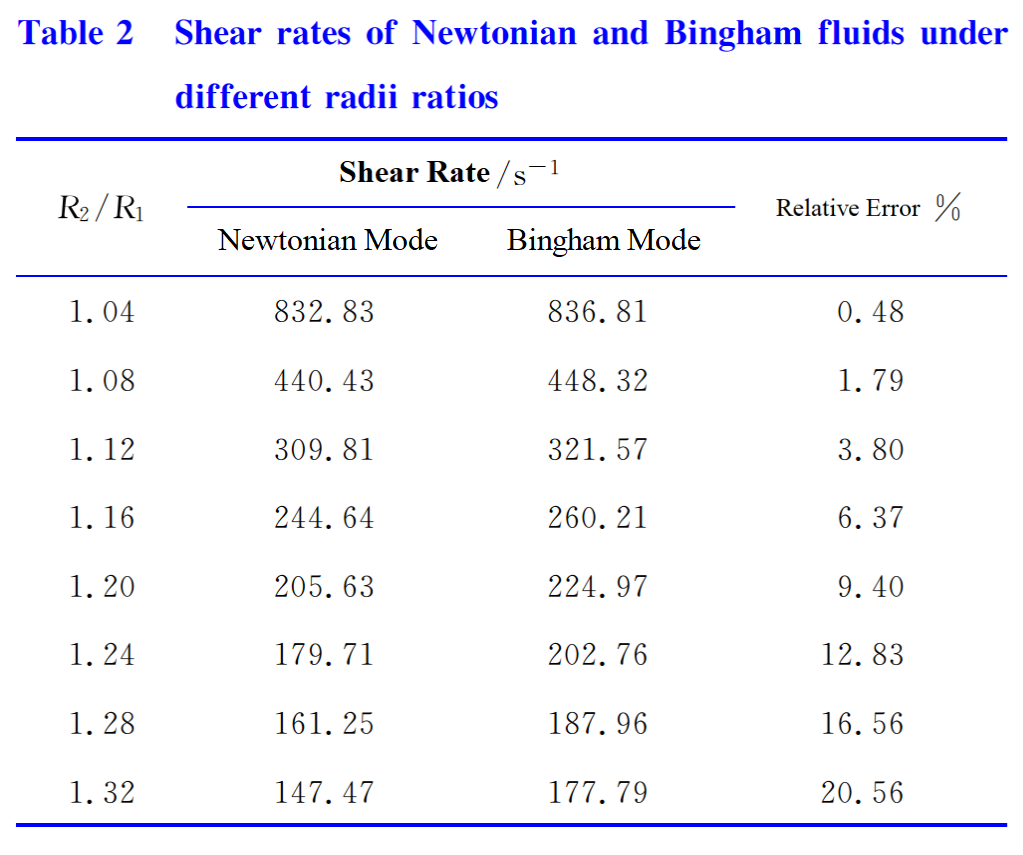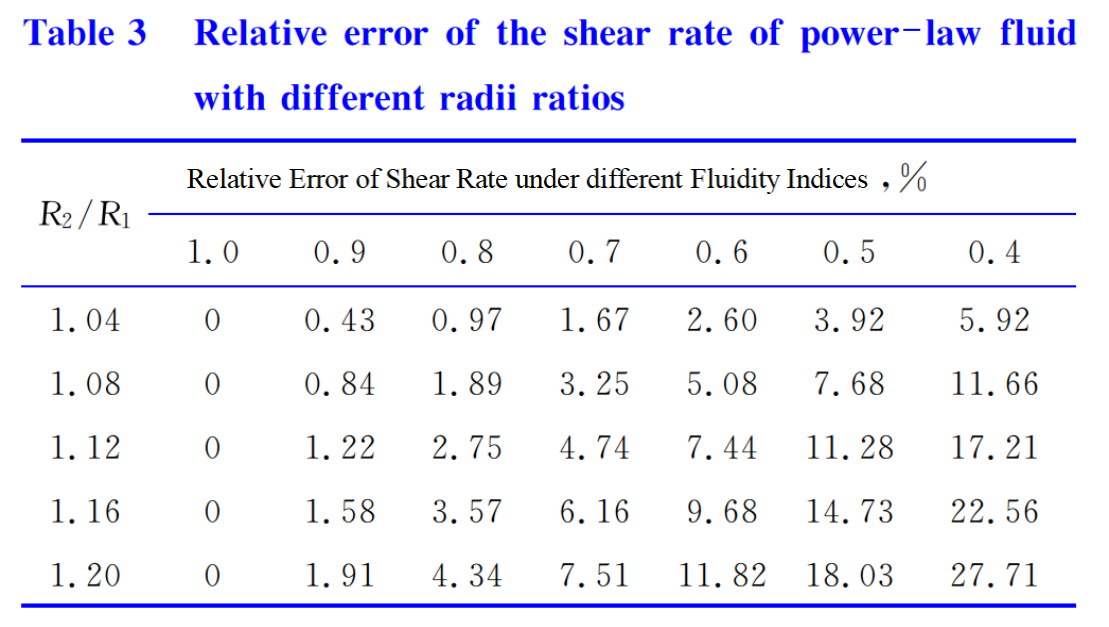Applicability of a New Device for Cementing Flushing Fluid Evaluation(Part 2)
2.2 The Flushing Fluid is Newtonian Fluid
From equation (13), it can be seen that when the tested flushing fluid is Newtonian fluid, the shear rate at the outer wall of the inner cylinder of the evaluation device is only related to the outer cylinder speed, and is independent of the properties of the tested flushing fluid. Through observation, it can be seen that equation (13) is deformed to be the same as equation (2), that is, when the flushing fluid is Newtonian fluid, the evaluation device can fully simulate the flushing fluid's erosion of the cementing interface in actual cementing, and can make the shear rates of the two completely equal, theoretically without any error. Therefore, when the tested flushing fluid is Newtonian fluid or an approximate Newtonian fluid, there is no theoretical error in using this device for evaluation.
2.3 The Flushing Fluid is Bingham Fluid
From equation (14), it can be observed that when the flushing fluid is a Bingham fluid, the shear rate at the outer wall of the evaluation device includes two parts: the shear rate when the flushing fluid is a Newtonian fluid and the shear rate caused by the dynamic shear force of the fluid. Therefore, equation (14) can be transformed into:
.png)
From equation (18), it can be seen that the shear rate in the second part is not only proportional to the dynamic shear force, but also related to the inner and outer cylinder radii of the evaluation device. Due to the fact that the dynamic shear force τ0 and plastic viscosity ηp of Bingham fluid do not vary with shear stress and shear rate, they are constant values and belong to the inherent properties of the fluid. So, under the same test fluid, the shear rate at the outer wall of the inner cylinder is only related to the ratio of the outer to inner cylinder radius. Table 1 shows the increase in shear rate of fluids with different dynamic plastic ratios compared to Newtonian fluids under different outer to inner cylinder radius ratios.

From equations (14), (18) and Table 1, it can be concluded that the increase in shear rate of Bingham fluid has the following patterns:
1). When the radius of the outer and inner cylinders and the properties of the measured fluid are constant, the increase in shear rate is constant and independent of the outer cylinder speed;
2). The increase in shear rate is related to the gap between the inner and outer tubes. The larger the gap, the greater the increase in shear rate and it increases linearly with the increase of gap;
3). The increase in shear rate is related to the properties of the liquid, and it approximately increases linearly with the increase of the dynamic plastic ratio of the liquid.
At the same rotational speed, the shear rate of Bingham fluid is greater than that of Newtonian fluid. Only when R2/R1=1.00, the shear rates of the two fluids are equal. However, it is difficult to achieve the same size for the outer radius of the inner cylinder and the inner radius of the outer cylinder. Therefore, the shear rate of Bingham fluid can only be corrected by analyzing the shear rate error of Bingham fluid relative to Newtonian fluid under different ratios of inner and outer cylinder radii. Using equations (13) and (14), the shear rates of Newtonian fluid and Bingham fluid with a dynamic plastic ratio of 1.0Pa/(mPa·s) were calculated under different ratios of outer and inner cylinder radii at an outer cylinder speed of 300r/min. The results are shown in Table 2. For the convenience of measurement, the outer radius R1 of the inner cylinder is generally fixed at 12.5mm, which is the size of a conventional rock sample. Therefore, the increase in shear rate of Bingham fluid relative to Newtonian fluid is only related to the inner radius of the outer cylinder.

According to Table 2, when the ratio of inner and outer cylinder radii is 1.04-1.20, that is, when the inner radius of the outer cylinder is 13.0-15.0mm, the relative error of the shear rate of Bingham fluid relative to Newtonian fluid with a dynamic plastic ratio not greater than 1.0Pa/(mPa · s) is less than 10%. According to Table 1, as the dynamic plastic ratio increases, the increment of shear rate also increases. Therefore, when evaluating flushing solutions with a dynamic plastic ratio greater than 1.0 Pa/(mPa·s), the radius ratio of the outer and inner cylinder of the evaluation device should be reduced to reduce errors.
2.4 The Flushing Fluid is a Power-law Fluid
When the flushing fluid is a power-law fluid, using the method of analyzing Bingham fluid, the expression formula for the shear rate of the power-law fluid at the outer wall of the inner cylinder can be obtained as follows:
.png)
In the formula, nm is the fluidity index of power-law fluid.
When nm in equation (19) is 1, γM is the shear rate of Newtonian fluid at the outer wall of the inner cylinder. The shear rate of power-law fluid at the outer wall of the inner cylinder is not a function of Newtonian fluid, and the factors that affect its shear rate are:
1). The shear rate of power-law fluids is related to the fluidity index, and the smaller the fluidity index, the greater the shear rate; The closer the fluidity index is to 1, the closer its shear rate is to Newtonian fluid.
2). As the gap between the inner and outer tubes increases, the shear rate increases.
3). When the gap between the inner and outer cylinders and the properties of the flushing solution are constant, the shear rate is proportional to the rotational speed.
Table 3 shows the error of shear rates of power-law fluids with different fluidity indices relative to Newtonian fluids.

According to Table 3, when the fluidity index is 1.0, it is a Newtonian fluid, and the relative error of shear rate is 0; When the fluidity index is greater than 0.6, the relative error of the shear rate at a radius ratio of 1.04-1.20 is within 8%; The smaller the radius ratio, the smaller the relative error of shear rate. Therefore, it is necessary to control the ratio of inner and outer cylinder radii to improve measurement accuracy.
In summary, when the flushing fluid is Bingham fluid or power-law fluid, the relative error between the theoretical shear rate and the actual shear rate can be calculated according to the formula derived in this article. When the radius ratio of the outer and inner cylinder is controlled within 1.20, and the flowability index of the flushing fluid is greater than 0.6 or the dynamic plastic ratio is less than 1.0 Pa/(mPa·s), the shear rate formula of Newtonian fluid can be directly applied. At this time, the relative error is within 10%, which can meet the requirements of on-site construction for calculation accuracy. Therefore, when designing the flushing fluid evaluation device, taking into account the above analysis and the actual processing level, R2/R1 is limited to 1.04-1.20.
3. Conclusions and Recommendations
1). When the flushing fluid is Newtonian fluid, the shear rate at the outer wall of the evaluation device is equal to that at the cementing interface, and there is no theoretical error.
2). When the flushing fluid is Bingham fluid, the shear rate at the outer wall of the evaluation device's inner cylinder is greater than that at the cementing interface, and the increase in shear rate increases linearly with the increase of the gap between the inner and outer cylinders and the dynamic plastic ratio of the flushing fluid.
3). When the flushing fluid is a power-law fluid, the shear rate at the outer wall of the inner cylinder of the evaluation device is greater than that at the cementing interface, and the increase in shear rate is related to the fluidity index and independent of the viscosity coefficient; The smaller the liquidity index, the greater the shear rate; The larger the gap between the inner and outer cylinders, the greater the shear rate; When the gap between the inner and outer cylinders and the properties of the flushing solution are constant, the shear rate is proportional to the rotational speed.
4). The radius ratio of the inner and outer tubes of the evaluation device is limited to 1.04-1.20. When the flushing fluid is a power-law fluid with a fluidity index greater than 0.6 or a Bingham fluid with a dynamic plastic ratio less than 1.0Pa/(mPa·s), the relative error between its shear rate and Newtonian fluid is within 10%.
5). The application scope and evaluation effect of the new flushing fluid evaluation device need to be verified through on-site construction, and further improved based on the verification results.
